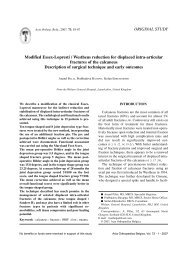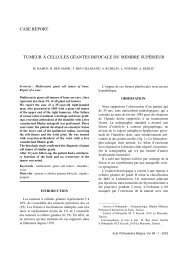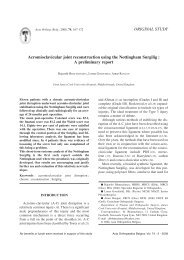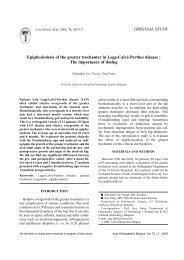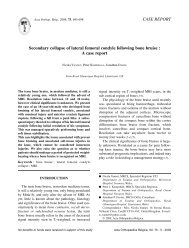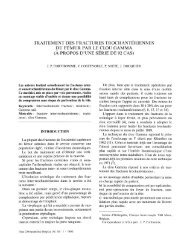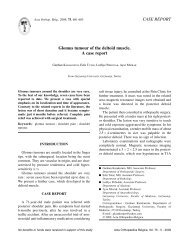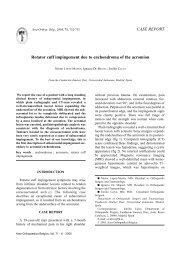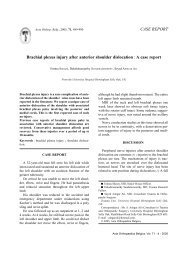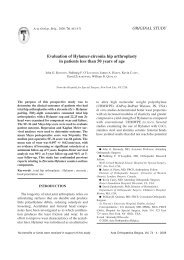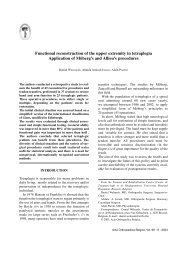download - Acta Orthopaedica Belgica
download - Acta Orthopaedica Belgica
download - Acta Orthopaedica Belgica
Create successful ePaper yourself
Turn your PDF publications into a flip-book with our unique Google optimized e-Paper software.
406 I. J. HARDING, I. M. MORRISfor non-operative treatment in patients withminimal symptoms. Surgery in these ‘minimal’cases resulted in 94% excellent results. With moresevere lesions the success of operative treatmentdecreases to 30% excellent results for simpledecompression, although it is stated this may beimproved with transposition and neurolysis. Whensurgery is indicated the preferred method of interventionremains controversial in the surgical literaturei.e. simple decompression, transposition ormedial epicondylectomy (1, 8, 13) although simpledecompression would seem to be adequate in themajority of cases (1).The aim of this study is to identify aetiologicalfactors in ulnar neuropathy and whether they determinepatient outcome. The anatomical locations ofthese lesions are identified and the roles of nonoperativeand operative treatment are assessed.PATIENTS AND METHODSOne hundred and forty eight consecutive patientswith a diagnosis of ulnar neuropathy between 1994 and1999 were prospectively assessed. The patient details,symptoms, known aetiology and treatment profile wererecorded. A full sensory and motor examination of bothupper limbs was performed including elbow flexion testand Tinel’s test. Where no clear aetiology of lesion couldbe obtained from history or examination e.g. injury(fracture, crush, direct blow), osteoarthritis, recent surgeryetc. then these were termed ‘idiopathic’.All patients had nerve conduction studies (NCS)and/or electromyography (EMG) to confirm the diagnosis.Patients were referred for electrodiagnosis from bothgeneral practitioners (48%) and in-hospital clinicians(52%). This was performed by a single rheumatologist(IMM), with a special interest in this field, who wouldthen instigate treatment depending on the severity, chronicityand progression of the lesion based on clinicalpresentation.All studies were undertaken in warmed limbs, byprior immersion in warm water.The standard tests used included an orthodromiculnar nerve sensory study stimulating with ring electrodesfrom the little finger to recording surface electrodesat the wrist ; these results were compared with the ipsilateralmedian nerve sensory studies from the index fingerto the wrist, and the contralateral ulnar nerve sensorystudy. Velocities for sensory conduction were calculatedand a velocity of more than 50 metres per second wasconsidered normal. Motor studies were undertaken inthe ulnar nerve with stimulation from the wrist and thenmore proximal points below and above the elbow as wellas in the upper arm to the adductor digiti minimi (adm)using surface or concentric needle electrodes to record.Distal latency as well as conduction velocity in the forearm,around the elbow and in the upper arm were measured.These studies were compared with the ipsilateralmedian motor nerve from the antecubital fossa and thewrist to the abductor pollicis brevis, as well as the contralateralulnar nerve. A normal motor nerve velocitywas considered to be more than 50 metres per second inthe forearm and upper arm, whilst more than 40 metresper second around the elbow in the ulnar nerve was considerednormal too. If appropriate distal motor latency inthe ulnar nerve from the wrist to the first dorsal interosseouswas undertaken and a difference in latency comparedwith that to the adm of less than one millisecondwas considered normal. EMG studies using concentricneedle electrodes were performed where indicated, either when nerve conduction abnormalities were foundor when there was clinical wasting and, or, weaknessAbnormalities looked for were activity at rest (fibrillationand positive sharp waves) and reduced interferencepatterns on maximal voluntary effort, both of these indicatingdenervation.All lesions with sensory changes alone were managedinitially non-operatively. This was also the treatment ofchoice in those patients where motor changes were presentbut in whom there was no pain and the symptomsremained static with no clinical suggestion of progressionor deterioration. Non-operative treatment involvedadvice regarding protecting the site of nerve compressionby modified activity and the provision of a tubipadbandage when the elbow was involved. These patientswere then all followed up clinically and by furtherNCS/EMG if indicated. If non-operative treatment failedthen the patient was referred to an orthopaedic surgeonfor operative decompression.Operative treatment was only used as first line treatmentin those patients with motor changes which wereprogressive or troublesome and all patients were advisedthat the aim of surgery was to prevent further deteriorationalthough some recovery of nerve function mightoccur.In this prospective longitudinal cohort study patientswere contacted by telephone and/or questionnaire one tosix years (median 3.8 years) following electrophysiologicaldiagnosis to determine clinical progress and outcome.<strong>Acta</strong> Orthopædica <strong>Belgica</strong>, Vol. 69 - 5 - 2003



